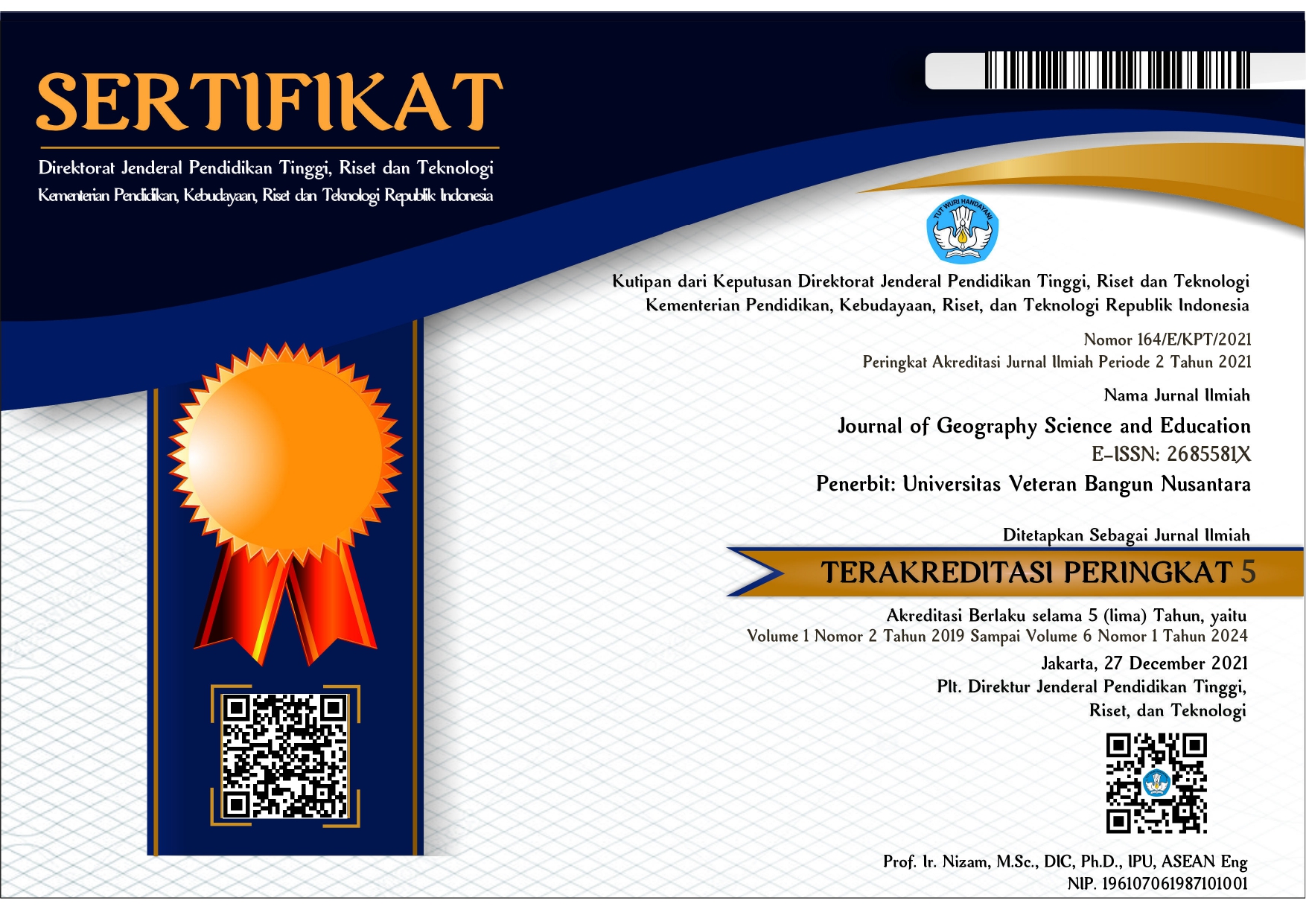CHANGES IN AGRICULTURAL LAND USE TO NON-AGRICULTURAL LAND IN GROGOL DISTRICT OF SUKOHARJO REGENCY IN 2001 - 2018
DOI:
https://doi.org/10.32585/jgse.v3i1.1386Keywords:
Land Use, Land Change, Image InterpretationAbstract
This research was conducted in Grogol Sub-District of Sukoharjo Regency. This research aims to: (1) find out the land use in Grogol Sub-District in 2001 and 2018 (2) to find out the changes in land use in Grogol Sub-District in 2001 - 2018. The methods used in this study are: (1) using the land use map in 2001 obtained from the Indonesian Earth View Map (RBI), while the land use map in 2018 was obtained from digitization of Quickbird satellite imagery published from Maxar Technologies by regulating the year of publication on September 05, 2018. (2) overlay method isused todetermine land use changes in 2001-2018. The results obtained in this study are the land use of Grogol Sub-District in 2001 covering an area of 3,116 hectares which includes 1,718 hectares of rice fields, 1,242 hectares of residential land, and 156 hectares of vacant land. Meanwhile, land use in Grogol Sub-District in 2018 was 3,116 hectares which includes 1,230 hectares of rice fields, 1,816 hectares of residential land, and 70 hectares of vacant land. The change in land use of Grogol Sub-District in 2001 - 2018 amounted to 1,186 hectares and the area of land that was not changed by 1,930 hectares. Grogol sub-district in 2001 and 2018 the pattern of land use change is elongated following the road, elongated following the river, and radial (thorough).
Downloads
References
Campbell, J. E., & Shin, M. 2011. Essentials of geographic information systems. https://www. saylor. org/books/.
Erma, Galing, and Ardita. 2016. "Changing Patterns of Community Shopping Movement After Building Modern Trade Center in New Solo". Regional and City Planning Study Program faculty of engineering, Universitas Sebelas Maret Surakarta
Gulani Indri, 2019. Evaluation of Land Use Changes Based on Spatial Land Resource Balance in Grogol Sub-District, Sukoharjo Year 2007 and 2017 Using Geographic Information System (SIG). Postgraduate Program of Geography Education Study Program, Yogyakarta State University.
Kim, C. 2016. Land use classification and land use change analysis using satellite images in Lombok Island, Indonesia. Forest Science and Technology, 12(4), 183-191.
National Statistical Bureau. 2001. Grogol Sub-district in 2001. Sukoharjo
National Statistical Bureau. 2018. Grogol Sub-district in 2019. Sukoharjo
Suharyadi, 2011. Hybrid Interpretation of Medium Spatial Resolution Satellite Imagery for Urban Area Building Density Study in Yogyakarta Urban Area. University of California, Berkeley.
Sunarhadi, M.A., Utaya, S., Astina, I.K.., Budijanto. 2018. Spatial Thinking Learning Tools: Teacher guides, media, and geography learning modules to develop students' spatial thinking skills.—Ed. 1, Cet. 1--, Sukoharjo: Geoinfolit, June 2018.
Thenkabail, P. S. 2016. Remote Sensing Handbook; Volume 1: Remotely Sensed Data Characterization, Classification, and Accuracies. Taylor & Francis.
Wahyudi, E. B. 2009. "Analysis of Land Use Changes in Sokaraja Kabupeten Banyumas Sub-District in 1994‐2004". Muhammadiyah University of Surakarta.
Published
How to Cite
Issue
Section
License
Authors who publish with the Journal of Geography Science and Education agree to the following terms:
- Authors retain copyright and grant the journal the right of first publication with the work simultaneously licensed under a Creative Commons Attribution License (CC BY-SA 4.0) that allows others to share the work with an acknowledgment of the work's authorship and initial publication in this journal.
- Authors are able to enter into separate, additional contractual arrangements for the non-exclusive distribution of the journal's published version of the work (e.g., post it to an institutional repository or publish it in a book), with an acknowledgment of its initial publication in this journal.
- Authors are permitted and encouraged to post their work online (e.g., in institutional repositories or on their website) prior to and during the submission process, as it can lead to productive exchanges, as well as earlier and greater citation of published work.










